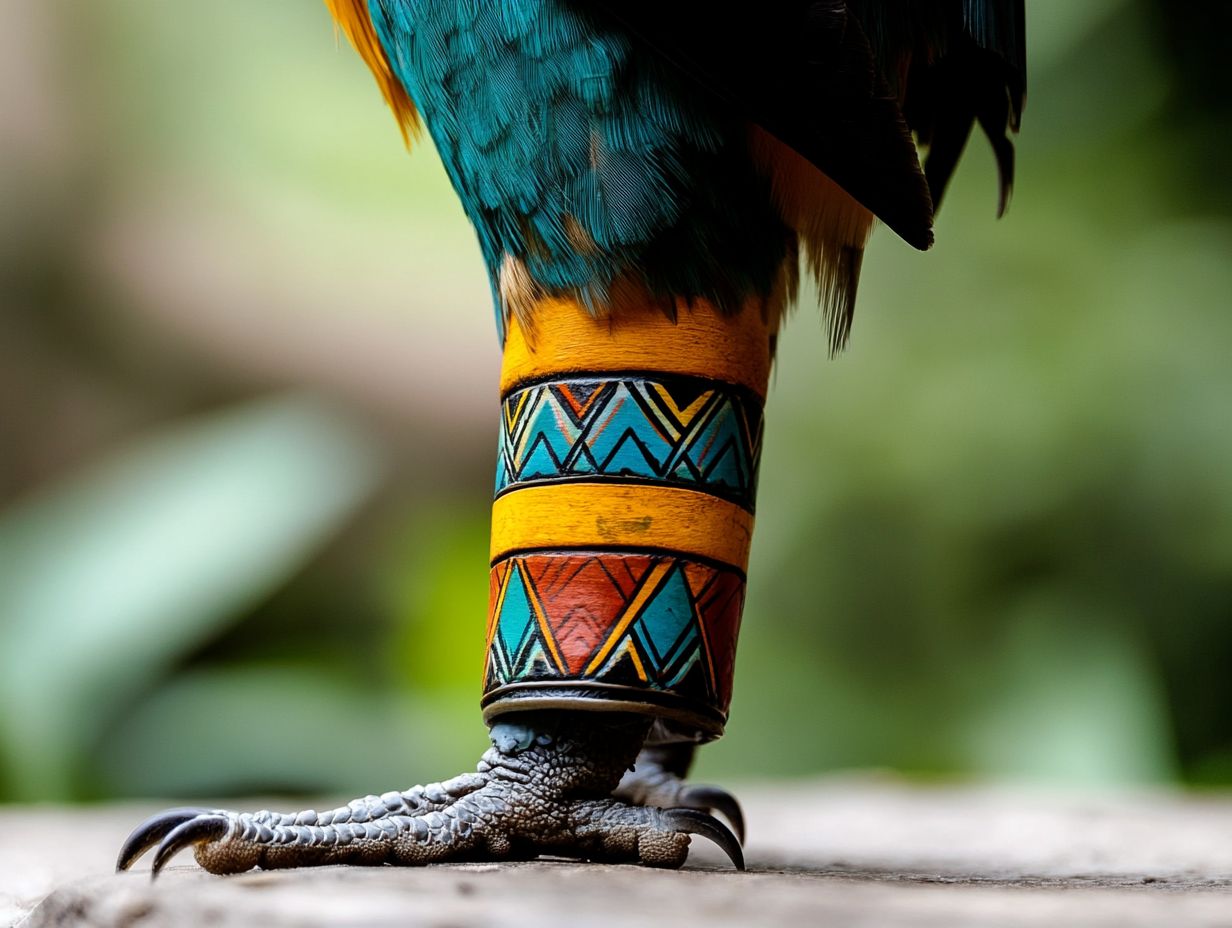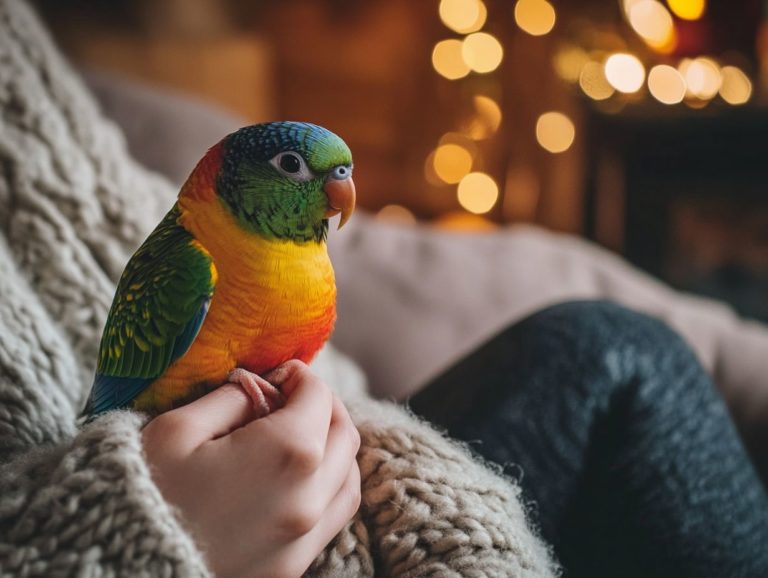What Should I Know About Bird Leg Rings?
Bird leg rings are indispensable tools in avian care, offering a range of benefits from identification to monitoring!
This article delves into the importance of these rings, highlighting the various types available plastic and metal and guiding you on how to select the perfect one for your feathered companion.
It also discusses safe techniques for applying and removing leg rings while addressing common concerns and misconceptions surrounding their use.
Whether you re a seasoned bird owner or just starting out in the hobby, this guide is designed to equip you with all the knowledge you need!
Contents
Key Takeaways:

- Bird leg rings are small, circular bands that are placed around a bird’s leg for identification purposes.
- The main purpose of bird leg rings is to provide a means of tracking and identifying individual birds for research and conservation efforts.
- When choosing a leg ring for your bird, consider factors such as size, material, and potential risks to the bird’s safety and well-being.
What are Bird Leg Rings?
Bird leg rings, often called leg bands, are essential tools for identifying various bird species and individual pet birds. For breeders in the US, these rings are crucial for ensuring proper identification throughout the birds lives, facilitating effective population tracking.
Available in various types, including closed and open bands, some even incorporate microchip technology for enhanced identification. The significance of leg rings goes beyond simple identification; they are vital for monitoring bird health and informed breeding practices.
Organizations like the USDA and the American Federation of Aviculture highlight the critical role these leg bands play in wildlife conservation and research. By providing a unique identifier for each bird, these tools empower breeders and researchers to gather vital data on migration patterns, breeding habits, and overall species health.
The integration of innovative technologies, such as microchips, amplifies this capability, allowing for swift and effective data retrieval while minimizing stress for the birds. Such advancements reflect a commitment to responsible aviculture, ensuring that the well-being of these remarkable creatures remains a top priority.
Purpose of Bird Leg Rings
The primary purpose of bird leg rings is to offer a dependable means of identification for various avian species, an aspect that holds significant value for breeders, pet owners, and conservation efforts alike.
As the number of imported birds continues to rise, the demand for effective identification methods has become increasingly critical. This ensures enhanced tracking of bird populations while facilitating thorough monitoring of bird health.
Why are Leg Rings Used?
Leg rings are crucial for the identification and tracking of pet birds, enhancing your breeding efforts and deepening your understanding of bird populations. By providing unique identifiers, these rings enable you to manage your avian stock with precision, ensuring accurate record-keeping and health monitoring throughout each bird’s life.
Additionally, leg rings play an essential role in tracking population dynamics, which is vital for conservation initiatives. By monitoring the movement and reproduction of birds within specific species, you gain valuable insights into health trends and can detect outbreaks of diseases like scaly mites and psittacosis.
These conditions can have serious repercussions, not just for individual birds but for entire populations if left unaddressed. Therefore, the use of leg rings transcends simple identification; it becomes a crucial instrument in fostering the overall well-being and sustainability of avian species.
Start using leg rings today to contribute to bird conservation and be a responsible bird owner!
Summary
In summary, bird leg rings are essential tools for ensuring the identification, health monitoring, and tracking of bird populations. By understanding their importance, you can make informed decisions that benefit not only your birds but also contribute to broader conservation efforts.
Types of Bird Leg Rings

Discover the amazing world of bird leg rings! You can choose from various options, including plastic and metal rings, tailored for identification and tracking.
Closed bands are generally for younger birds. Open bands are easy to put on and take off, making them great for pet birds and breeders.
Some of the latest leg rings include tiny chips that enhance your tracking capabilities.
Plastic vs Metal Leg Rings
Plastic and metal leg rings each have unique advantages. Plastic rings are lighter and easier to apply, while metal rings are durable and wear-resistant.
These features affect avian health and management. For example, plastic rings suit smaller or less active species, while metal rings work better for larger breeds.
Plastic rings are quick to apply, but they might not last as long as metal ones. It’s vital for breeders and bird owners to assess their birds’ needs when choosing leg rings.
How to Choose the Right Leg Ring for Your Bird
Choosing the right leg ring requires careful consideration of your bird’s size, breed, and the ring’s purpose.
Proper identification ensures effective tracking and breeding. Make sure the leg ring fits your pet bird perfectly.
Factors to Consider
Key factors to consider are the bird’s size, breed, and the purpose of the ring. Understanding these helps ensure proper identification and supports your bird’s health.
Size is crucial; a tight ring can cause injury, while a loose ring can fall off. Different breeds have unique traits that require specific ring dimensions for a secure fit.
Leg rings do more than identify; they’re useful for tracking lineage and monitoring breeding schedules. Veterinarians also use them for keeping accurate health records, which helps ensure better care for your bird.
Applying and Removing Leg Rings

Applying and removing leg rings requires careful techniques to keep your bird safe. Mishandling can lead to injury or distress.
Be gentle and use the right tools for the type of leg ring. Your careful approach ensures a secure and stress-free experience for your feathered friend.
Proper Techniques and Precautions
When putting on and taking off leg rings, using the right techniques and precautions is crucial for your bird s well-being. Using the right tools minimizes stress and can prevent injury and discomfort, making the experience smoother for both you and your feathered friend.
It’s essential to choose leg rings that fit properly no constriction allowed. Using tools designed for this task can help secure or release the ring without excessive force. When it comes time to remove the leg ring, consider using a gentle lubricant, like a light oil, to ease the process and avoid snagging any feathers or skin.
Always maintain a calm environment, as unexpected noises can startle your bird, increasing the chances of accidental harm. Monitoring your bird after applying or removing the leg ring is vital for its health, allowing you to quickly address any complications that may arise.
Common Concerns and Misconceptions
Common concerns and misconceptions about bird leg rings can create confusion for both bird owners and breeders. It’s understandable to worry that leg rings might cause discomfort or health problems for your pet birds.
However, when applied and maintained correctly, these identification tools offer significant benefits. They enable you to effectively track and monitor the health of your avian companions.
Addressing Myths and Misunderstandings
Addressing the myths and misunderstandings surrounding leg rings is vital for you as a bird owner. This knowledge allows you to make informed decisions about your feathered friends. Many fears center on potential health issues or discomfort associated with leg rings, yet proper application and care can greatly alleviate these concerns.
Recognizing that leg rings, when fitted correctly, serve essential functions such as identification and tracking is crucial for your pet’s well-being. Some may worry that these rings hinder a bird’s natural behavior or lead to injury. However, this is simply not the case if the rings are appropriately sized and regularly monitored. Conducting annual checks can help prevent complications, ensuring that your bird remains comfortable and secure.
By debunking these myths, you can prioritize your avian companion’s health and safety, creating an environment where they can truly thrive.
Frequently Asked Questions

What Should I Know About Bird Leg Rings?
Bird leg rings are small, circular bands that are placed around a bird’s leg for identification purposes.
What are bird leg rings made of?
Bird leg rings are typically made of lightweight materials such as plastic or aluminum. Some may also be made of stainless steel or other metals.
Why are bird leg rings used?
Bird leg rings are used to identify individual birds and keep track of their age, origin, and breeding history. They are commonly used by bird breeders and researchers.
How are bird leg rings put on?
Bird leg rings are usually put on when a bird is young and its leg is still small enough to fit through the ring. The ring is then closed around the bird’s leg using a special tool.
Do bird leg rings hurt the bird?
When properly applied, bird leg rings should not cause any harm or discomfort to the bird. However, it is important to ensure the ring is not too tight or too loose, as this can cause injury.
Are there different sizes of bird leg rings?
Yes, there are different sizes of bird leg rings to accommodate various bird species and ages. It is important to choose the correct size for your bird to ensure a comfortable fit.
For more tips on keeping your bird happy and healthy, check out our other resources!






